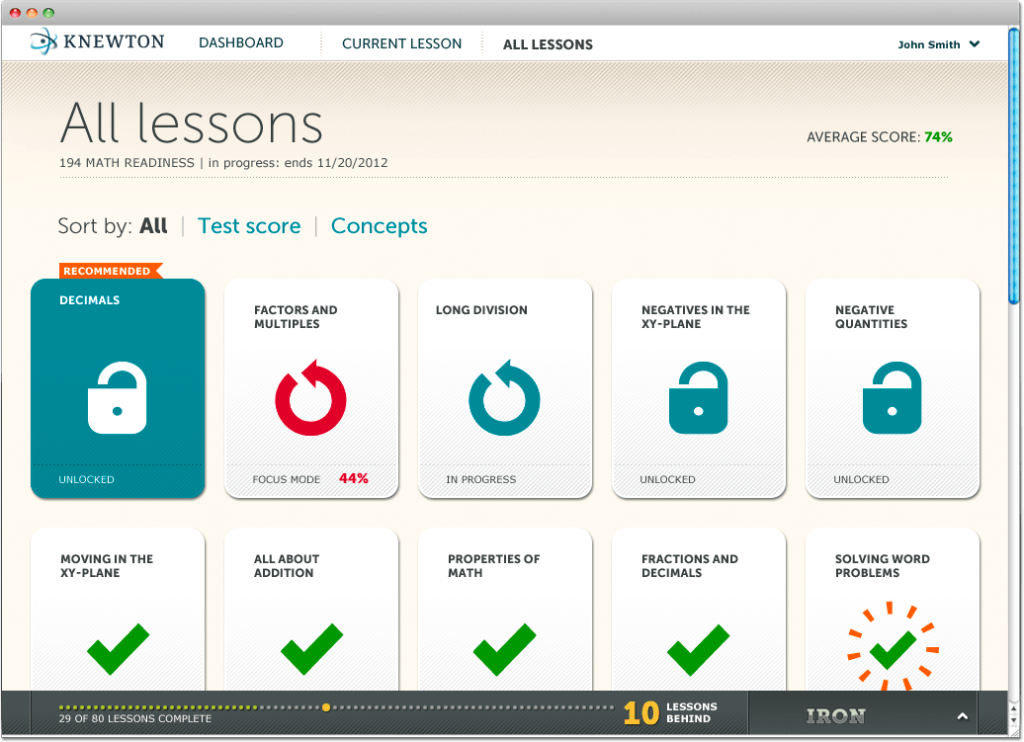Knewton Engages Students With Personalized, Adaptive Math Courses

Big data, personalized learning, and adaptive learning have been among the biggest trends at this year’s conferences about innovations in learning. Which players in this growing sector are on the right track? We’ve had our eye on Knewton, which is developing an adaptive learning platform to power personalized online and blended courses in higher education and K12. The platform is showing compelling results in math readiness courses at Arizona State University.
Irene Bloom, a Senior Lecturer at Arizona State University (ASU) teaching primarily freshman math courses, began working with Knewton in November 2010 for a Math Redesign Project. She reviewed and contributed to the curriculum, which turned into a “flipped classroom” pilot in the Summer of 2011.
Bloom began as a skeptic wondering, “How could they learn without me?” Yet, after visiting the University of Alabama and witnessing the online programs with their students, she felt confident that the Knewton program was worth a try. Immediately she saw how the program engages students in learning and makes better use of lecture time.
“When the content is delivered online, I can spend my time engaging students in problem solving and critical thinking,” says Bloom. “The students are much more engaged in class.”
What’s more is that Knewton has allowed Bloom to introduce collaborative learning, allowing students to move along at their own pace. “I love looking around the classroom and seeing them working in groups, talking to each other and explaining things to each other,” says Bloom. “I only step in when they are stuck.”
“Most of the time, different groups are working on different things, depending on where they are in the course,” adds Bloom. “This is very new for me. Before this, I worked on the assumption that all students were at the same place. Now, because they progress at different rates, I meet them where they are.”
Knewton offers a variety of analytics that help educators evaluate when students are learning the material, what questions they’ve answered correctly, how long they spend on a section and more. This data helps educators tailor what material they choose to cover in the classroom with students and who in particular needs additional support.
“What is interesting is that I have so much more information about what my students do (or don’t do) outside of class,” says Bloom. “I can see where they are stuck, how fast they are progressing, and how much time and effort they are putting into learning mathematics.”

So far, Bloom has seen tangible results in her courses. Her students’ grades last semester were better than those in Summer 2011, which was taught in the traditional model, and withdrawal rates are down. Knewton is bringing about similar improvements in other classrooms at ASU. A total of five thousand freshman enrolled in Knewton-powered remedial math courses last fall. After just one semester of use, course withdrawal rates dropped by 50 percent and pass rates increased from 66 percent to 75 percent.
“I think the biggest difference is that the system forces students to master a topic before they move on,” says Bloom. “They can’t just throw up their hands and say ‘I don’t get it.’ They have to keep working on it.”
Bloom has noticed a difference in her students as well. One student in particular who waited until her last semester of her senior year to complete a freshman math requirement, not only completed the course with an A grade, but early. Blooms attributes this to the way that the Knewton course allowed her to choose her study time and move along at an individualized pace.
“She was able to watch the videos and practice on her own time,” says Bloom. “She liked being able to control her learning. She could watch and rewind and practice as much as she needed. Then, when she came to class, she knew what questions she needed to ask. It was great to watch her progress and see her confidence grow.”
Fifty percent of the 5,000 students enrolled in the Knewton-powered remediation course finished a month early.
Bloom says that we need to eliminate the assumption that all students learn in the same way and at the same rate. In addition, she adds that we need to eliminate the need to micromanage students’ experiences. “I think this will be our greatest challenge as a community,” says Bloom.
She adds that new platforms like Knewton place a greater learning responsibility in students hands, allowing them to customize and personalize their experience for their personal learning needs. “I think that will benefit students enormously in the long run,” adds Bloom.
“The technology and its ability to adjust and adapt to the student can only improve with time,” says Bloom. “If faculty can embrace this, it will be great.”






0 Comments
Leave a Comment
Your email address will not be published. All fields are required.